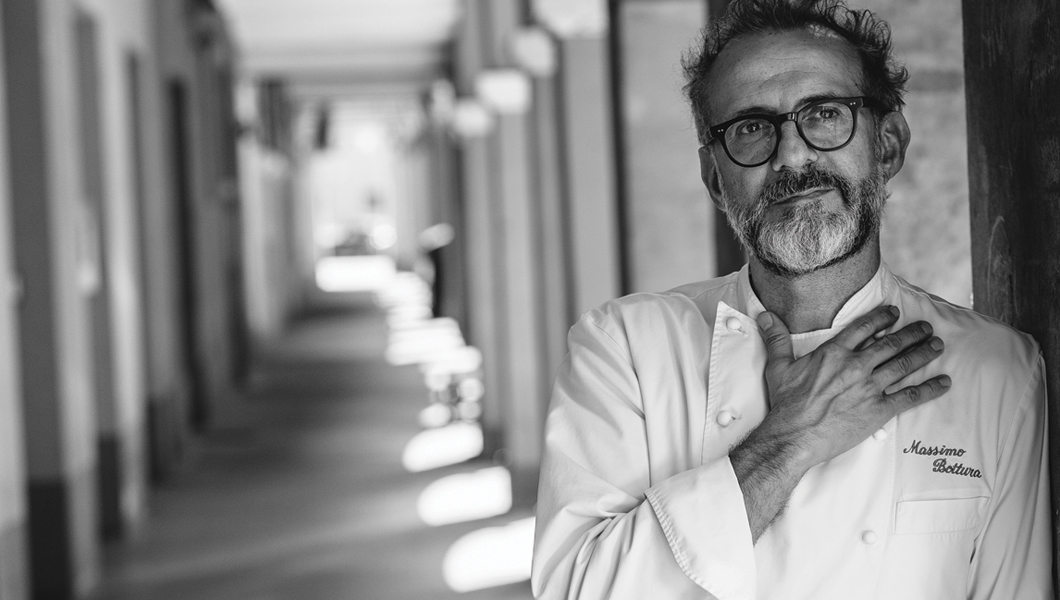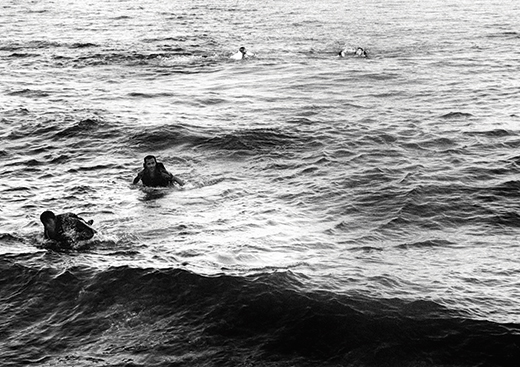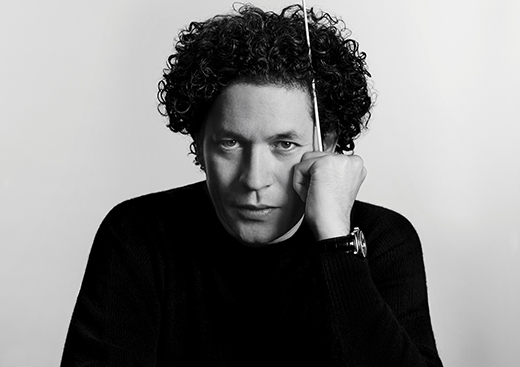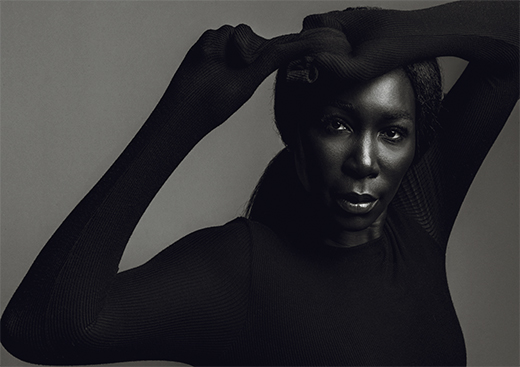Massimo Bottura’s first lesson on how to be a good chef happened on the soccer field, not in the kitchen. “It’s not about cooking. It’s about being a leader. You have to learn how to take decisions and read the eyes of the people that are working with you,” says the world-famous Italian toque. “I learned how to do that as a young soccer player at age 15. “I was very good at what I was doing; the team counted on me.”
At 54, the chef—who still knows how to have his way with a futbol—hasn’t stopped putting his leadership skills to the test. As the chef patron of Osteria Francescana, the three-Michelin star restaurant that topped this year’s list of the World’s 50 Best Restaurants, Bottura is a champion of avant-garde Italian cuisine. On a global scale, he’s revered for his fight against food waste and world hunger.
“Italy is a place kissed by God,” explains Bottura. “We eat to live and we live to eat. It’s in our DNA.” Family meals played a central role in Bottura’s own childhood, with his grandmother and mother dedicating themselves to feeding the extended family, including Bottura’s three brothers and sister—“almost every day it was a party of 20 or more,” Bottura says, recalling Emilian specialties like homemade tortelli and tortellini. And with older brothers who brought a teenage Bottura along on food and wine tours, his culinary horizons continued to reach new heights. One particular memory stands out in his mind: “They forced me to eat oysters, and since then, I’m crazy about them!” (The experience gave way to a dish on his menu, the Tribute to Normandy).
So it’s no surprise that Bottura has always felt a connection to food. Simply put, “The door of the gastronomic world was open,” he says, “and I walked through it.” In 1986, after giving up on the idea of a career in law, a 23-year-old Bottura opened the doors to a small trattoria, Campazzo, on the fringe of his hometown of Modena, a city just shy of 200,000 in the gastronomy-obsessed Emilia-Romagna region of Northern Italy, which prides itself, among other things, as the birthplace of balsamic vinegar.
The Campazzo years were formative ones for the newly minted restaurateur, who also studied under influential French chefs Alain Ducasse and Georges Cogny during this period. It was here where Bottura also befriended one of his most influential mentors—a local villager named Lidia Cristoni who imparted her traditional pasta-making techniques and years of wisdom garnered from working in restaurant kitchens upon the eager chef (who also credits her with teaching him “humbleness and how to be ready for service.”). “The more I dug deeper into this world, the more my interest became a passion,” says Bottura. “Once you have a passion, you can’t stop. You live it.”
But it wasn’t until the mid-nineties—after Bottura had sold Campazzo and opened his flagship restaurant, Osteria Francescana, with his now wife and collaborator, Lara Gilmore, in Modena—that he began to really tilt the axes of the world of Italian cuisine. “Sometimes, tradition doesn’t have much respect for the ingredients. So I started looking at the past in a critical, not nostalgic, way, and bringing the best from the past into the future,” says Bottura. He compares the process to a mental image he has of a Chinese dissident artist Ai Wei Wei’s 1995 performance piece “Dropping a Han Dynasty Urn,” in which he smashes a 2,000-year-old vase. “I’m breaking my past to build the future. That’s the point.”
Following an apprenticeship with Spanish chef Ferran Adria, the visionary behind the now-shuttered elBulli (which also once held the distinction as the world’s best restaurant), Bottura began to approach his craft with a fresh perspective, harnessing traditional Italian ingredients and flavors into new forms. “Ferran was the one who really opened my mind and terms of freedom to express yourself,” explains Bottura, who had already begun to chip away at the cornerstones of Italian tradition with early, innovative dishes like the abstract Cappuccino, a savory riff on an Italian classic using potato and onion paired with balsamic vinegar, and served with a ciccioli frolli powder croissant, and Three Stages of Parmigiano Reggiano featuring three interpretations of its namesake cheese in different textures and temperatures (the current iteration of the dish features five options, including a mousse and a crunchy chip). “I had to show everyone that I really could cook better than their mothers” says Bottura, who was criticized early on in his career for his almost sacrilegious approach. A fusion of art and familiar Italian flavor profiles and ingredients, Bottura’s creations also capture a sense of nostalgia: Memory of a Mortadella Sandwich, for instance harkens back to his school-break lunches through a foam of mortadella
The restaurant is not just an ode to avant-garde Italian cuisine, but also Bottura and Gilmore’s shared passion for contemporary art: works by Bosco Sodi, Gavin Turk, Francesco Vezzoli and Duane Hanson dot the walls of the 12-table restaurant. Bottura’s love of music makes appearances on the menu in the form of dishes such as the black cod-driven Tribute to Thelonious Monk, an ode to the famed jazz pianist, and Autumn in New York, a dedication to Billie Holiday’s jazz song in the form of a vegetable and foie gras medley with a pour-over broth. (You’re as likely to find Bottura sourcing original Bob Dylan and BB King vinyl at the monthly local antique market as you are combing the farmers’ market for in-season produce.)
In 2002, the restaurant was decorated its first Michelin star, followed by a second in 2006, and a nearly unattainable third in 2012. In 2011, the International Academy of Gastronomy anointed Osteria Francescana the number one restaurant in the world.
Bottura doesn’t feel any pressure to maintain his status as one of the world’s most recognized chefs; he does, however, feel an obligation to use his influence to effect change. “It’s very important that I use my position to raise my voice, to move the spotlight from me to others. It can be farmers, cheese makers, or poor people. We confirm the problem, then we solve it using my spotlight,” he says. Case in point: when earthquakes struck his native Emilia-Romagna in 2012, Bottura devised a risotto cacio e pepe recipe to utilize thousands of wheels of Parmigiano Regiano that had been damaged in the disaster. The dish became a national sensation. “Italians in general are extremely, extremely social. We give our best moments when we are hit by something. When we need it we are extremely social and we care a lot about the others,” explains Bottura.
That same philanthropic spirit also shines through in Food for Soul, Bottura’s non-profit that turns the spotlight on food waste and hunger. During the 2015 ExpoMilan, Bottura debuted Refettorio Ambrosiano, turning an abandoned 1930s theatre into a modern-day refectory in collaboration with a team of artists, architects designers, and sponsors. Sixty chefs from around the world came together cook for the city’s underserved, using leftovers. Over a five-month period, the team—which included the likes of Adria, Ducasse, Rene Redzepi and Mario Batali—transformed 10 tons of food waste from the Expo into 150 healthy meals a day. “I want the most influential chefs in the world to understand the mentality of their grandmothers,” says Bottura of the concept, which teaches chefs not to throw anything in their kitchens away.
“After Milan, we received so many requests to open Refettorio in Tokyo, in London, everywhere. I said to Lara, ‘how can we do this?’” The Food for Soul foundation was born, and during the 2016 Olympics, Bottura, Gilmore, their two children, Alexa and Charlie, and another star-studded list of chefs headed to the host city of Rio de Janeiro to launch the next incarnation of his modern-day soup kitchen, Refettorio Gastromotiva. “[The chefs] trust me,” he says. “They know who I am and why I am doing this. During my 31 years of experience in this work, I’ve built credibility, and every single chef who came to Milan said, ‘I want to come back for Rio.’”
Brazil was much harder than Milan, he says, because he saw “things he couldn’t imagine.” But he was ready for them. “[These people] don’t have hope, and with [Refettorio Gastromotiva], they had something incredible to wait for. Because at 6 p.m., they could spend a couple of hours in a place that treated them like human beings.”
And whether he’s serving luminaries like Mark Zuckerberg and Robert De Niro, or children on the streets of Rio, Bottura’s approach is one and the same: “For me, it’s like I’m giving everything to everyone, because this is my passion,” he says. His ultimate goal, he says, is to work towards reducing a projected number of 860 million starving people in the world in 2050 by half. “If I can open the minds of people, of companies, of politicians, maybe we can do it,” he says. “Open 10, 100, 1,000 Refettorios around the world.”
At the end of the day, projects like the Refettorios can’t exist without Osteria Francescana. “It’s a laboratory of ideas. It’s where we create culture, and culture brings knowledge and a constant sense of responsibility.” The next step, he says, is bringing spirituality into the mix. How? He doesn’t know yet. What he does know is the feeling of excitement and responsibility he felt in Rio. “I always keep the door open for the unexpected, because it’s the most amazing thing ever to be surprised,’ he says. “That’s the secret of a great life.”
—





